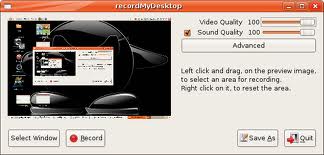 After reading the article “How to create a screencast of your Linux desktop” I started doing some test of screencast with the program recordmydesktop.
After reading the article “How to create a screencast of your Linux desktop” I started doing some test of screencast with the program recordmydesktop.
In particular, I did some testing with both the gtk frontend to the command line, but unfortunately in the first trials i was not able to get any sound in the video.
But first a small step back.
recordMyDesktop is a desktop session recorder for GNU / linux
that attemps to be easy to use, yet also effective at it’s primary
task.
As such, the program is separated in two parts; a simple command line tool that performs the basic tasks of capturing and encoding
and an interface that exposes the program functionality in a usable way.
The commandline tool (which essentially is recordMyDesktop),
is written in C, while there are two frontends, written in python with
pyGtk (gtk-recordMyDesktop) and pyQt4 (qt-recordMyDesktop).
After some research on google I read that the most common reason for this problem is the setup of your mixer.
I then started doing a lot of tests with alsamixer and the sound mixer of xfce, but I must say that i fail with all of them, until I found a post on ubuntu forums that spoke of using pavucontrol.
I then installed pavuncontrol and simply changing on its screen the output device has got everything to work correctly, how to do it ?
Follow this very short screencast.
So to make it short:
- aptitude install pavuncontrol
- open pavucontrol from your menu -> multimedia (or where you have it)
- start a video a song or whatever cause your computer to sue audio
- start recordmydesktop
- in pavucontrol go in the tab “recording” and change the device associated with recordmydesktop
- All done.
Popular Posts:
- None Found

gtk-recordMyDesktop (records video + audio) and gnome-sound-recorder (records audio) can record both the system and the microphone sound. To choose the sound to be recorded open gnome-volume-control (from ALT+F2 for example), click on Hardware, then on Profile and there choose the corresponding option, depending on what will be recorded ..:
+ sound of the system: a) Analog Stereo Output; or b) Digital Stereo Duplex (IEC958)
+ sound from the microphone: a) Analog Stereo Duplex; or b) Digital Stereo (IEC958) Output + Analog Stereo Input
In gnome-volume-control, it may be necessary to choose “Off”, close it, open it again, choose the desired option and close it again.
Some of the other options may work sometimes, but they may record sometimes the system sound and sometimes the mic sound. And other options may record audio but could not permit to listen to the recorded sound. So it’s better not to use those options.
NB: system sound is the sound of what one can hear from the speaker. It can be a .ogg or .mp3, … song played by Totem, or a Flash music video of a web site, …
In Ubuntu I’ve tried xvidcap and gtk-recordMyDesktop. I’ve been able with both of them to record video and audio from the system or the microphone.
But gtk-recordMyDesktop has 2 problems:
a) When you click on stop it takes a lot of time to encode the video (in xvidcap you have it in the moment you stop the recording).
b) It uses a lot of space in a folder called more or less /tmp/rMD-session-xxxx. Sometimes is deleted after the encoding but sometimes not (keeps on growing) and you have to delete it before your Linux root partition (/) gets full.
In Ubuntu, to be able to record the sound with xvidcap you just need to follow a few steps:
http://ubuntuforums.org/showthread.php?t=1714139